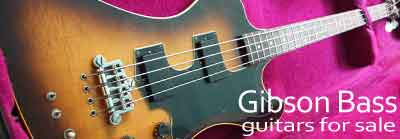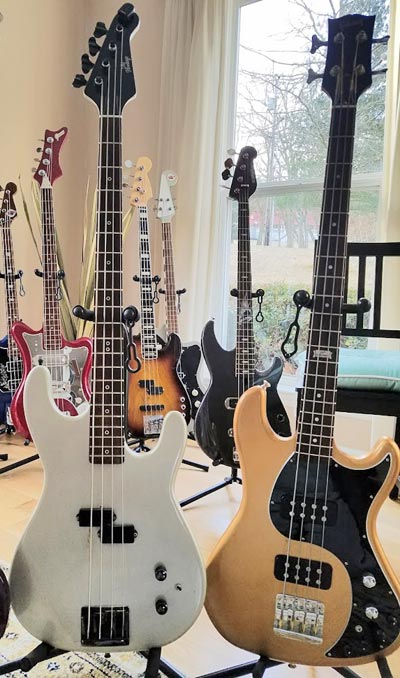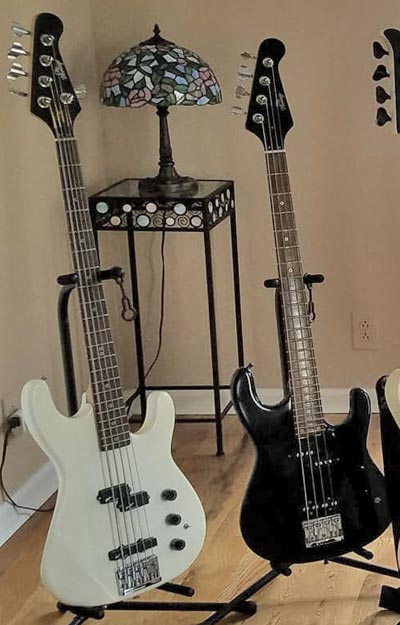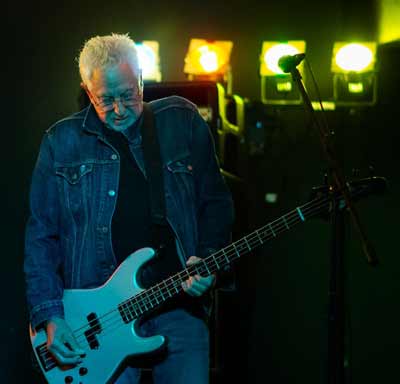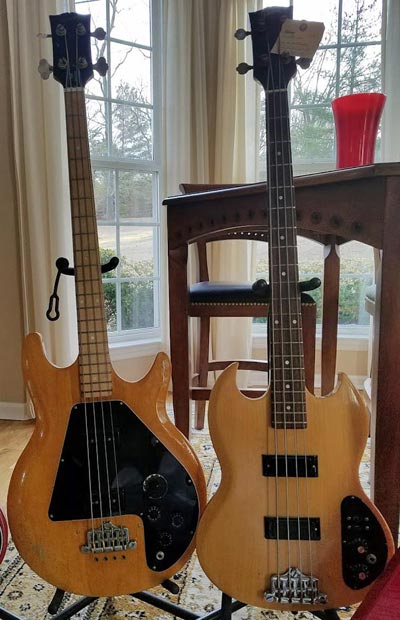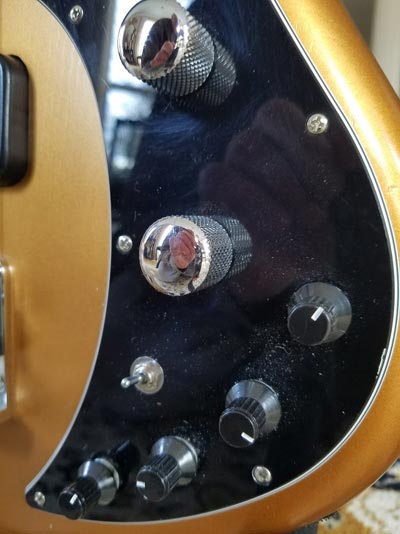Heritage, Fender, Gibson and Peavey
Heritage basses
Dave Kiswiney Heritage was born like in 85/86 and I'd moved to Nashville but I still went back to Ann Arbor to rehearse with Ted and I went over to Kalamazoo, we had talked. They built me a gold bass, a silver bass, a black bass, and a (black) 5 string.
I kept the silver one because it just had the best neck and the best sound. It had the early active pick-ups in it. It is the best bass i've played in my whole entire life, out of all the basses. And I consider it a Gibson, because those were the guys that made the Gibsons, those were the guys that designed them: Chuck (Burge) and Jim (Deurloo) and Marvin (Lamb), you know. And they gave it to me in '85 or '86, and i'm still using it. It just blows people. It's a simple mahogany body, maple neck, long scale, hardwired EMGs, not the plug-in types, and a Schaller bridge, bolt on neck. Something about the marriage there, the way they did it, that's pretty cool, so that's in my Gibson family here, that Heritage.
I asked them for a 5 string, and Jim said, yeah... and I've got it. They made one and said what do you think?, and it's got a little bigger headstock on it, a wider neck, but the strings are so close together I just have to play it with a pick. They never manufactured it, it's sitting in the house here. They gave it to me, and after I had the medium scale Explorer, I said could you make me a medium scale Heritage? "Well we'll do you one better than that, we'll make it two octave 24 fret medium scale"... and it's absolutely amazing, it's incredible... it's just got passive pickups in it, but it's a two octave, in tune, Heritage medium-scale bass.. and it's the only one. They never made it again, they just made it for me.
I sold the black one and the gold one. The all black on black on black didn't have the neck right.. it was way too small, it didn't sound good, I sold it to a guy that put it on a wall in a music store somewhere in Virginia, $800... stupid... but you know we've all done it, come on how many times have you sold a guitar for money.. to eat.. we call it eat "I ate that one".
I got a really nice Yamaha I got from a music store friend of mine, but I mean, it's beautiful and plays great, but it doesn't sound anything like the Heritage does. I take the Heritage to a gig and a backup. I don't take any of the other ones with me anymore. I used to take the Victory, when I played up at a little place in town, a small little fish house and the sound man, everybody loved it "bring that red one... sounds so good".
I was taking the Victory prototype with me for a long time, but now I take the Heritage because (it) just works for me, it just works. One volume, one tone. I roll treble back all the way off it and boost it on the amp and give it a little edge on the tone control if I need it. But it sustains, it sings, every note is even and loud, there's no dead spots, it just plays. I take the Heritage, which is a Gibson to me. It's the last of the Gibsons.. it's the last of the Gibson's I'm telling you.. and they don't even make them anymore.
FlyGuitars What did you like about Gibson basses in particular?
Dave Kiswiney I think when I started playing in the '60s there wasn't sound reinforcement, you had to make it sound good with what you had. A 50 watt Fender Bassman head and a 15 inch speaker turned towards the wall in the corner of the room that you played in, so that it would at least be a folded. It would give more bass if you turned around towards the wall. And Gibsons were just fat: big fat, hand wound pickups. And being short scale was even better, so that's why, that's why I liked it. You know I liked the short scale, my hand seemed to fit well, but now it seems really small. The Teisco was a short scale, the EB of course, had a 30" scale on it. Jack Scott gave me that Fender bass and I was like holy crap how am I going to find my way around on this thing! Once that's what you play and that's what you do... short scales you can run away on. I still have a couple of short scale basses. That's why the Gibsons. Besides, I think I was revolustic in a way. There were so many basses coming out: Ampeg had a great one, Ovation had a great one. Of course all the Japanese stuff that was been marketed. They were all good sounding basses, but I just preferred the Gibsons. And I got more attention from other bass players. Why do you play the Gibson? Why don't you have a Fender? What difference does it make? I can make this sound as good as I want it to. And they always had something different to offer. The Gibson luthiers were always trying to find something different to do.
I look at some of the Fenders for 50, 60, 70 thousand dollars, and I really don't know what it is about them, to be honest with you. I'm a Gibson snob, if you will. But I never took a guitar from anybody else, there was Ledo. Joe Ledo from Canada made this beautiful bass and wants me to play it, I took it out and tried it, I ended up giving it back to him. Yamaha same thing, Steinberger same thing. Never liked headstock-less guitars. Peavey gave me a couple neckthrough Dyna basses, and jazzed them up with active electronics, and I've got two of those. They really played good. They were really, really good. But I was never an artist endorser. They gave me amplifiers; they tried to give me, and I said well I don't.. well you just keep it. So the roadie kept it. The bass tech kept it. I told him I don't want it.. I kept the basses but I didn't keep the.. there was a lot of stuff like that, companies were giving it away. They'd bring it to you, and they'd go "here take it". They were doing their job. They were like "you go out, take this, go to that concert, meet the guitar player, the bass player, and get them to try it out and get a picture with him and let's go". So what's a piece of gear? They were leaving it with you.
FlyGuitars Tell us about the Ledo?
Dave Kiswiney It was one of those basses that would have been a really beautiful coffee table, you know what I'm talking about? I mean they put so much work into the wood and the laminating and it's just so gorgeous. It had gold hardware and this and that, they did everything to make it sound good you know and it was beautiful. The guy was Canadian and he came to the gig with this bass in a road case and said I want you to have this and I went wow yeah you know sure, and I actually gave it back to him you know like a couple months later.. I said man I'm not playing this you know if you just want to take it back he was not happy with me but I gave it back to him you know. Why keep it?
FlyGuitars And the Peavey?
Dave Kiswiney It's called a Dyna bass, neck through and active. It's got a neck like the Heritage and a (Fender) Jazz. I had a red one and a blue one; it turned green but it was kind of a transparent blue. They're really nice: they sit around here I pick them up every once in a while and they look good, but the main one was the Heritage.
Fender
Dave Kiswiney I have 3 or 4 Fenders. I bought them out of necessity because engineers in these recording studios. Track one was bass on the board, right? it was always bass... and then drums, kick drum, down 1, 2, 3, 4 on the inputs. They had their stuff set for Fender Precision bass with a DI. Period. That's what they wanted you to use. That's the reason I own Fenders, and they're nice, you know. I just don't ever take them out and play them.
FlyGuitars Your first Fender was the '58 Precision, that you took the pickups out of. What happened to the rest of it?
Dave Kiswiney I can't remember. I really don't know. I can't tell you what I did with it. I probably sanded it down and sold it to somebody. It was a white one. It had a tortoise shell pickguard on it... it didn't matter, we did what we had to do to have a tool, something we could take out and play and be really good with. I didn't care for the Fender - wish I had it now of course. I mean it's the same way with a lot of cars I bought.. you go from one to another, you've just got to keep going.
FlyGuitars But all your recordings with Ted Nugent were with a Fender?
Dave Kiswiney I had moved to Maui before I got in the Nugent band, anyways I bought that Fender bass for two hundred Bucks. I saw it in the paper it was like: Fender bass, brand new, $200, case. And I drove to the other side of the island. A kid had got it and decided he didn't want to play bass. I bought it off of him for $200, and I brought it back to the mainland and stored it in the studio there. They wanted me to use a Fender on the Scream Dream album you know how engineers are they already know how they like to set the bass on track one or down there someplace, channel one, so the roadies took that bass and put Dimarzios in that too and they're still on it, I haven't restored it to original, but it's a great recording bass with those Dimarzios in there without a doubt. All the Nugent stuff I did on record was done with the '78 Precision, Fender, with Dimarzio pickups. The old hard-wired allen-wrench adjustable polepiece white Dimarzios. That's the one that I recorded with Pat Travers (Hot Shot). I never really got a Gibson on any of those national records.
Other basses
Dave Kiswiney When Gibson moved out of Kalamazoo... they were closing it down, and Pat Aldworth, who was my Artist Rep, said "hey man we've got to go to the factory they're having a sale; they're getting rid of some stuff, you gotta go". So we went, and I bought, I wish I still had it, a Thunderbird bass that was on the cafeteria wall for $200. And I bought, and I still have the tag for it, an SB400, and it was on the cafeteria wall, but it has a bgn stamp, a bargain stamp, on the back of it. And it's got the same neck as the Ripper, exact same neck as the Ripper: 3 piece neck, it's a set neck. You know it was cheesy because they routed out the front of the guitar and put a plate on, two controls. They say it's a 400 but I think it's a 450. It's got a black headstock and a maple body.. and you know it just falls down when you put it on. Head heavy, you know, you've got to hold it up. But it's a great player... I bought that for 100 bucks, the Thunderbird for 200 bucks, and an acoustic guitar, an Epiphone with all kinds of mother-of-pearl inlays, it was a bargain for 100 bucks. I could have bought Les Pauls. I just didn't, you know I wasn't thinking straight. I guess. But that was enough for me. I wish I had the Thunderbird. I had to eat it. There were times in between when I wasn't touring or I wasn't working. I was trading and selling and, somebody would offer me money for stuff.
You know they never let prototypes out of the factory. They used to burn them, Cut them in half. Can you imagine? some of the stuff that they do. And I know the guys that work there got out of there with some pretty cool stuff. You know there's stuff around.
New Gibson EB
Dave Kiswiney I played a little thing to raise money for a Gibson employee, needed money for cancer fund, so I got invited to that and I took the white one (Victory), and Steve Mills and some of the other guys were really interested in the bass, Frank Johns. And they invited me out to the factory and they wanted to keep it and measure it up and maybe do a prototype of it, so I left it with them for a while, and they loved it so much. They didn't do the prototype, but they gave me a bass. They built a bass for me as a surprise for letting them do that. That was the latest model, they just called it an EB. It had those two pickups in it you know. But they built it active; they put an active board in it that's the only one they did. They said "we know you like active so here we put this circuit board in it" it's amazing. It's the only EB with an active circuit board in it. It's pretty cool.
They had Thunderbirds sitting around there but they had acid on the Chrome and the pickups I made them look old, they're making them like relics. and I was begging Jim Decola, Steve Mills I said man I want to buy one of those I said we can't we can't sell all those to you were just messing around with it.
Gibson EB0 (slotted headstock)
Dave Kiswiney I like to sit around and play that little EB0 that I have, and it's just wonderful to sit and play it, so easy. I don't think I could take it. I played it live one night and I let somebody play it and they hacked it up started banging on it with bracelets. I don't take it out anymore, but that thing is louder then any active bass that I have. That little thing is unbelievable. I've opened up the cavity and looked at the wiring. I took a picture of it and send it to Jim Decola and I said what's up with this, it's got the capacitor hanging off it's open ended and there's nothing connected here. I took it apart and everything works: the tone works, and the volume works, but man it's so loud.. and it'll distort. If I have an amp with a gain and an output, you know an input gain, I have to back the input gain way down, because it will overdrive the front end of the amp, that's how powerful it is. I think that's what Gibson did, they wound those pickups until they ran out of wire.. couldn't get any more on.
Amplification
FlyGuitars Tell us about amps?
Dave Kiswiney The first amp was a Gretsch 50w 2x12 open back, then it went to a Fender Bassman 50w head and a Fender bottom. It was huge. It had a cut out for an 18 inch speaker, but it has an adaptor that took it down to 15 inch speaker. I bought it from my music store and it was huge, and it sounded good, because I always go to a gig and I put it face it towards the wall, or the corner if there was a corner. I'd face it towards the wall it was like a folded horn you know, and with that Gibson bass it would be loud - it would be boomy and we didn't have any sound support. And then as things got bigger I bought a Traynor amp, a Canadian amp, from Ann Arbor music. It was a 100 watt tube head, the bottoms were 8x10s there were 2 8x10 bottoms. It was huge. With a 100w tube amp you know, I was actually overpowering the band, they only wanted me to use one bottom, and it got to be too big just to haul it around, so I started taking one cabinet.
I eventually traded that for an Acoustic 18 inch with a folded horn with an 18. Acoustic 360 - and that was it.. that was great, you know... that was the amp. I kept blowing up the amplifier part of it. It was made by Cerwin-Vega, Acoustics were made by Gene Czerwinski. I kept blowing out the capacitors, and he would mail me capacitors, those big tall cans that's what would blow up, and I'd solder them in and off i'd go.
I got rid of the Acoustic amp when I joined the Nugent band. That was 1979 they got rid of the wall of Sunns that Rob Grange used to use. He beat the crap out of it. They were all blonde; they were just distorted and raggy, and the techs and the sound man, Dansir McCulloch, said we're going to build you an amp. And they built a stereo P.A. bass amp. One stack had four 15s: 2x15 bottom, 2x15 bottom on top of each other; on top of that was a folded horn with two 12s; and on top of that was an array of eight 4 inch JBL tweeters. And I had two stacks like that, and each stack was powered by 2 Crown PSA2s with the Yamaha electronic 3 way stereo crossover. And there was a parametric EQ. It was ridiculous, absolutely ridiculous. It would shake your pant legs. They put one on each side of the stage. That's what Nugent wanted, he wanted a stack on each side of the stage next to the Drum riser. You can see it in that live 1979 day on the green that's on YouTube, although they had put the stacks next to each other. They quit separating them because Ted wanted all of his stuff on one side of the stage and Charlie Hulme and I were on the other. And then I took it down to one cabinet because it was way too loud. Everything was so loud. If it weren't for earplugs... it was loud I'm telling you. My ear plug would fall out if I wiped the sweat off my face, knock out that little foamy, it would like disorientate you for a second it would be so loud. And then my bass tech would run up with one of them all twisted up and he'd shove it in my ear. When the tour ended, when it was over in 1989, they sent me the amps and the rack. They said you can have it, and they gave it to me. I didn't get the speakers, but somewhere along the line Gallien Krueger, who I also endorsed, built me a wall of 18 inch, 15 inch, 10 inch, and 12 inch cabinets and they put it on a rack, (and) gave it to me and it didn't sound good at all. It did not work and Nugent made me go back to the folded horn thing, so anyways they gave me the amps and I shipped them all to Nashville and put them in a storage facility.
I've got a 15 inch bottom which I use I still use and I've got 2x10 bottom, no 12s. So if I had a stack it'd be an 18 in Gallien-Krueger, with a 15 inch on top of that and then a 2x10 cabinet on top of that, and a Sunn Coliseum 300 to power it; an old parametric amp that I keep in working order and I would use that for a stack.
But if I go out and I take an amp to play I'll take a 15-in Gallien-Krueger bottom, but I replaced the speaker it's got a B52 in it which is a really good little speaker. I power it with a Hartke 300w head that I bought from a church for 50 bucks and it's in a rack. I'll take it anywhere I've played city wineries, and I take it with me if I have to play a gig with Derek and we go off and do a 3 or 4 piece gig. I take that amp and it works great 1x15 300 watt head and an old boss chorus for Stranglehold that's my rig. I take it anywhere with sound support being what it is these days, they've just got to di in the back you know a low impedance out put a cable in it and run it through the board stage monitor it sounds really good. In the house, I have one of those Gallien-Krueger MB200s. I think it's 100w with a 12 inch speaker in it and it's portable; it's got a bag if you want to take it to a small gig I've taken that before I use it in the house that's what's in the house when I play and it's plenty loud.
There's a lot of guys that they have powered speakers and they have all kinds of really cool things out there right now, but at a club they have got to have bass amps and drum kits anyway and drummers take their cymbals and sticks, hardware, you know pedal, and the bass player just shows up with a bass, because there's so many bands rotating through that you can't even unload your gear. One club has a Traynor 4x10, and the head is amazing. It's got a tube front end, or a solid state front end, you can pick whatever you want. I use the tube front end and it's the best sounding bass amp in that room. I love it. And it's got a bad speaker in it, one of the speakers is a little rusty a little rough, and I love it. It's so warm with that Heritage, it's the coolest thing. I can't wait to go back there and play it again. I'm going to play it on March 30th with Derek. I hope they don't replace it!
Thanks to Dave Kiswiney for taking the time to be interviewed, and for supplying images
Gibson bass guitars for sale
1968 Gibson EB-0 Bass Rare Slotted Head w / Original Case (EXC ) Stunning!!
Racine, Wisconsin, 534**, UNITED STATES OF AMERICA
$3995
... more
VINTAGE 1981 Sunburst Gibson Victory Artist Series 4 String Bass Guitar w / Case
Interlochen, Michigan, 496**, UNITED STATES OF AMERICA
$1620
Up for sale is a rare vintage 1981 Gibson Victory Artist Series bass guitar in a beautiful sunburst finish. This model was part of Gibson??s early ??80s ??Victory?? line, designed for versatility and modern tone
Year / Model: 1981 Gibson Victory Artist Series (4-string)
Finish: Classic Sunburst
Pickups: Professionally upgraded with custom EMG pickups (not original) ... more
70s Japanese Bass With Gibson Logo
Trenton, New Jersey, 086**, UNITED STATES OF AMERICA
$549
... more
1965 Gibson EB-2 Bass a very special ordered EB-2 in a factory Argentine Gray !
Fort Lauderdale, Florida, 333**, UNITED STATES OF AMERICA
$8995
Gibson EB-0 BASS with Slotted Headstock 1969 - Cherry
Jackson, Michigan, 492**, UNITED STATES OF AMERICA
$2795
We offer a RARE Slotted Headstock Gibson EB-0 Bass Guitar "Short Scale" S / N: 928316 which I believe makes this a 1969These had what they called "Mudbucker" pickups which sound much fuller and deeper than your standard pickups. They sound really cool!I understand that these short scale basses are easier for guitar player to pick and play. I have to agree It all works as it should This Bass has seen to use but is just honest playing and not abused. Check out the pics and ... more
Gibson Victory Artist Bass 81'
Blackfoot, Idaho, 832**, UNITED STATES OF AMERICA
$3800
Gibson Ripper (L9-S) Bass Guitar with Seymour Duncan
New Florence, Pennsylvania, 159**, UNITED STATES OF AMERICA
$3500
This bass is in very good condition. There are a few small marks located in the pictures. Feel free to ask questions, can send more pictures. Must have at least 10 positive comments to purchase. For sale in the United States Only
... more
GIBSON VICTORY STANDARD BASS GUITAR - RARE
Saint Petersburg, Florida, 337**, UNITED STATES OF AMERICA
$1550
... more
1968 GIBSON EB SERIES, LES PAUL BASS CHROME TUNERS SET OF (4) WITH SCREWS
Berlin, New Hampshire, 035**, UNITED STATES OF AMERICA
$225
This is a chrome set of (4) tuners from a 1968 EB-O that will also fit EB-2 and EB-3 basses. These are correct for models from 1968 thru 1972. Vintage Fender bass tuners are a dime-a-dozen (well maybe not that cheap) but these areextrremely difficult to fins as a complete set. All (4) tuners are in great shape and operate very smoothly; these were made by Schaller and are branded 'Gibson' on the little dust cover. Includes the mounting ... more
Vintage 1966 Gibson Electric Bass Guitar
Los Angeles, California, 900**, UNITED STATES OF AMERICA
$2312
I do not know much about vintage guitars , but i took this guitar to the nearest Guitar center store and was told that is a 1966 Gibson Electric Bass( if someone thinks differently , please let me know).
There are some scratches here and there ( please see the pictures)
Comes without a original case. ( still in a nice soft case)
Plays great.
Original big fat Gibson pickup is super warm and sounds ... more
Gibson Non Reverse Thunderbird Bass Guitar
Beach City, Ohio, 446**, UNITED STATES OF AMERICA
$1599
... more
Gibson Classic 1966 EBO Bass Guitar
Adrian, Michigan, 492**, UNITED STATES OF AMERICA
$2100
1965 Gibson Thunderbird IV Bass in Pelham Blue oh-so rare & cool you need it !
Fort Lauderdale, Florida, 333**, UNITED STATES OF AMERICA
$13495
1964 Gibson Thunderbird IV Bass 1 of the best originals it's 1 of a kind & Minty
Fort Lauderdale, Florida, 333**, UNITED STATES OF AMERICA
$27495
1966-68 GIBSON CARE+SETUP GUIDE GUITAR & BASS 20 PAGES GREAT ILLUSTRATIONS RARE
Berlin, New Hampshire, 035**, UNITED STATES OF AMERICA
$279
In 50 years of playing and over 30 years of selling I have never seen another one of these! This piece is way cool with its understated design, interesting layout and beautiful 2-color illustrations. It looks like they commissioned a famous illustrator to do the work! It's got 20 pages and is packed with information on setting up, caring for, handling, making adjustments and just appreciating your Gibson instrument in general. 60's Gibson... more
1958 Gibson EB-2 1st year Museum Quality 100% original its 1 of a kind & Minty !
Fort Lauderdale, Florida, 333**, UNITED STATES OF AMERICA
$9995
1961 Gibson EB-3 the cleanest original extent w / hang tags 1 of a kind & Minty !
Fort Lauderdale, Florida, 333**, UNITED STATES OF AMERICA
$11495
1961 Gibson EB-6 string Bass Sunburst w / PAF
Carbondale, Illinois, 629**, UNITED STATES OF AMERICA
$14900
Add Me to Your Favorite Sellers
Olivia's Vintage would like to present this 1961 Gibson EB-6 Bass in its original Sunburst finish. It has a great playing neck with great frets. It's all original with the exception of the earlier Gibson knobs, the switch and one tuning key. All original tuning key is included, but its tuning button had shrunken and crumbled. A vintage double-ring Gibson Deluxe tuning key is holding the place for the original. The original hardshell case is included. This ... more
1963 Gibson EB-0 Cherry Vintage Short Scale SG Bass, 100% Original w / Case
Seattle, Washington, 981**, UNITED STATES OF AMERICA
$3600
Featuring solid Honduran mahogany construction and a rosewood fretboard, this EB-0 weighs 7lbs 13oz. The famous ??Mudbucker?? pickup ... more
1963 Gibson EB-0 Cherry Vintage Short Scale SG Bass With Gigbag
Lincoln, Nebraska, 685**, UNITED STATES OF AMERICA
$1600

